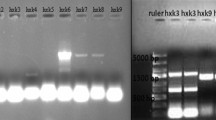Summary
Hexokinase isoenzyme PI was cloned using a gene pool obtained from a yeast strain having only one functional hexokinase, isoenzyme PI. The gene was characterized using 20 restriction enzymes and located within a region of 2.0 kbp. The PI plasmid strongly hybridized with the PII plasmids isolated previously (Fröhlich et al. 1984). Hence there was a close relationship between the two genes, one of which must have been derived from the other by gene duplication. In conrrast, glucose repression was restored only in hexokinase PII transformants; PI transformants remained non-repressible. This observation provided additional evidence for the hypothesis of Entian (1980) that only hexokinase PII is necessary for glucose repression. Furthermore, glucose phosphorylating activity in PI transformants exceeded that of wild-type cells, giving clear evidence that the phosphorylating capacity is not important for glucose repression.
Similar content being viewed by others
References
Barnett JA, Kornberg HL (1960) The utilization by yeast of acids of the tricarboxylic acid cycle. J Gen Microbiol 23:65–82
Beggs JD (1978) Transformation of yeast by a replicating hybrid plasmid. Nature 275:104–109
Bergmeyer HU (1970) Methoden der enzymatischen Analyse, 2nd edition. Verlag Chemie, Weinheim, FRG, p 432
Ciriacy M (1975) Genetics of alcohol dehydrogenase in Saccharomyces cerevisiae. I. Isolation and genetic analysis of mutants. Mutat Res 29:315–326
Clewell DB, Helinski DR (1970) Supercoiled circular DNA-protein complex in Excherichia coli: Purfication and induced conversion to an open circular DNA form. Proc Natl Acad Sci USA 62:1159–1166
Colowick SP (1973) The hexokinases. Methods Enzymol IX, 1–48
Entian K-D (1980) Genetic and biochemical evidence for hexokinase PII as a key enzyme involved in carbon catabolite repression in yeast. Mol Gen Genet 178:633–637
Entian K-D (1981) A carbon catabolite repression mutant of Saccharomyces cerevisiae with elevated hexokinase activity: Evidence for a regulatory control of hexokinase PII synthesis. Mol Gen Genet 186:278–282
Entian K-D, Fröhlich K-U (1984) Saccharomyces cervisiae mutants provide evidence of hexokinase PII as a bifunctional enzyme with catalytic and regulatory domains for triggering carbon catabolite repression. J Bacteriol 158:29–35
Entian K-D, Mecke D (1982) Genetic evidence for a role of hexokinase isoenzyme PII in carbon catabolite repression in Saccharomyces cerevisiae. J Biol Chem 257:870–874
Entian K-D, Zimmermann FK (1982) New genes involved in carbon catabolite repression and derepression in the yeast Saccharomyces cerevisiae. J Bacteriol 151:1123–1128
Entian K-D, Zimmermann FK, Scheel I (1977) A partial defect in carbon catabolite repression in mutants of Saccharomyces cerevisiae with reduced hexose phosphorylation. Mol Gen Genet 156:99–105
Fröhlich K-U, Entian K-D, Mecke D (1984) Cloning and restriction analysis of the hexokinase PII gene of the yeast Saccharomyces cerevisiae. Mol Gen Genet 194:144–148
Gancedo C, Salas ML, Giner A, Sols A (1960) Reciprocal effects of carbon sources on the level of an AMP-sensitive fructose-1,6-diphosphatase and phosphofructokinase in yeast. Biochem Biophys Res Commun 20:15–20
Gancedo C, Schwerzman N (1976) Inactivation by glucose of phosphoenolpyruvate carboxykinase from Saccharomyces cerevisiae. Arch Microbiol 109:221–225
Gaséon S, Neumann NP, Lampen JO (1968) Comparative study of the properties of the purified internal and external invertases from yeast. J Biol Chem 243:1573–1577
Holmes DS, Quigley M (1981) A rapid boiling method for the preparation of bacterial plasmids. Anal Biochem 114:193–197
Kelly RB, Cozzarelli NR, Deutscher MP, Lehman JR, Kornberg A (1970) Enzymatic synthesis of deoxyribonucleic acid. XXXII. Replication of duplex desoxyribonucleic acid by polymerase at a single strand break. J Biol Chem 245:39–45
Lobo Z, Maitra PK (1977) Genetics of yeast hexokinase. Genetics 86:727–744
Maitra PK (1970) A glucokinase from Saccharomyces cerevisiae. J Biol Chem 245:2423–2431
Mandel M, Higa A (1970) Calcium dependent bacteriophage DNA infection. J Mol Biol 53:159–162
Matsumoto K, Uno J, Toh-é A, Ishikawa T, Oshima Y (1982) Cyclic AMP may not be involved in catabolite repression in Saccharomyces cerevisiae: Evidence from mutants capable of utilizing it as an adenine source. J Bacteriol 150:277–285
Matsumoto K, Uno J, Tatsudo I, Ishikawa T, Oshima Y (1983) Cyclic AMP may not be involved in catabolite repression in Saccharomyces cerevisiae: Evidence from mutants unable to synthesize it. J Bacteriol 156:898–900
Nasmyth KA, Reed SJ (1980) Isolation of genes by complementation in yeast. Molecular cloning of a cell-cycle gene. Proc Natl Acad Sci USA 77:2119–2123
Polakis ES, Bartley W (1965) Changes in enzyme activities in Sacharomyces cerevisiae during aerobic growth on different carbon sources. Biochem J 97:284–297
Southern EM (1975) Detection of specific sequences among DNA fragments separated by gel electrophoresis. J Mol Biol 98:503–517
Spiegelman S, Reiner JM (1947) The formation and stabilization of an adaptive enzyme in the absence of its substrate. J Gen Physiol 31:175–193
Steitz TA, Anderson WF, Fletterick RJ, Anderson CM (1977) High resolution crystal structures of yeast hexokinase complexes with substeates, activators, and inhibitors. J Biol Chem 252:4494–4500
Struhl K, Stinchcomb DT, Scherer S, Davis RW (1979) Highfrequency transformation of yeast: Autonomous replication of hybrid DNA molecules. Proc Natl Acad Sci USA 76:1035–1039
van Wijk R, Ouwehand J, van den Bos T, Koningsverger VV (1969) Induction and catabolite repression of glucosidase synthesis in protoplasts of Saccharomyces carlsbergensis. Biochim Biophys Acta 186:178–191
Witt I, Kronau R, Holzer H (1966) Repression von Alkoholdehydrogenase, Malatdehydrogenase, Isocitratlyase and Malatsynthase in Hefe durch Glucose. Biochim Biophys Acta 118:522–537
Zamenhoff S (1957) Preparation and assay of deoxyribonucleic acid from animal tissue. Methods Enzymol. 3:696–704
Zimmermann FK, Kaufmann I, Rasenberger H, Haußmann P (1977) Genetics of carbon catabolite repression in Saccharomyces cerevisiae: genes involved in the derepression process. Mol Gen Genet 151:95–103
Zimmermann FK, Scheel I (1977) Mutants of Saccharomyces cerevisiae resistant to carbon catabolite repression. Mol Gen Genet 154:75–82
Author information
Authors and Affiliations
Additional information
Communicated by H. Böhme
Rights and permissions
About this article
Cite this article
Entian, KD., Kopetzki, E., Fröhlich, KU. et al. Cloning of hexokinase isoenzyme PI from Saccharomyces cerevisiae: PI transformants confirm the unique role of hexokinase isoenzyme PII for glucose repression in yeasts. Molec Gen Genet 198, 50–54 (1984). https://doi.org/10.1007/BF00328699
Received:
Issue Date:
DOI: https://doi.org/10.1007/BF00328699



